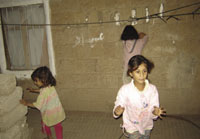
Yemeni traditional games: Remembering our childhood [Archives:2007/1102/Last Page]
November 12 2007
 |
[email protected]
Without disrupting their specialized small world, children still enjoy their childhood by playing traditional games. Traditional Yemeni children's games are many, but some have disappeared while others remain popular. Fatima Al-Ajel explores these various types of traditional games in a series. This fourth part describes games played by both boys and girls either together or separately.
Children ages 3 to 8 often gather in groups to play together. Many games are shared by both boys and girls; however, some games played by both are considered boys' and girls' games, but played separately, especially after a certain age.
The nature of these types of games depends on the group of players. For example, children in a family may play together or even children in a particular zone may gather to enjoy time playing. Such games create cooperation and build children's cultural and social ties.
In his research on the social communication theory contained in his “Children's Divan in Yemeni Public Literature,” author Ali Hadad mentions that during play, children attempt to imitate the social behaviors in their community. “Environment plays a role in forming a child's character and future personality through practicing the social traditions most common in society,” he explains.
Ghada wa asha, or lunch and dinner, is mostly a girls' game, but because boys often like to play the male roles, girls accept their joining in to play.
Ghada wa asha essentially is a reflection of their community as they mimic whatever their parents do in real life. They start by assigning the family roles to each child; for example, the eldest girl in the group is the mother, while the boys play the father and sons. It's similar to a play wherein the children act out their community life on stage.
They then set up the family home, bringing the necessary items. Play commences with the mother preparing lunch. She busies herself with cleaning the house, caring for the children and cooking lunch, while the father goes to work with his sons.
Sometimes, only girls play this game, so the theme of play changes as the girls concentrate on playing the roles of women in their neighborhood and how they interact with each other within their particular zone.
Child psychology professor Najat Sauem explains that this game reflects children's social interactions through such play. Children attempt to capture the elder generations' roles through such games. This game particularly develops the specialized roles for both boys and girls in their future society.
The group game Malahagah is either a girls' game or sometimes a mixed game where children assign the game's roles. They first select one child to be the evil one, who runs after the other children, while another acts as the mother and tries to save the children from jail and from being caught by the evil one.
When a child is caught, he must go to jail while the other children must get close to the jail and touch him to release him; however, they face difficulty in doing so because the evil one is there. So, they devise a plan that some children will distract the evil one while the others go to save the prisoners with help and advice from the mother. They must run as fast as possible while the other children escape from the jail. Then the game is over.
Malahagah is a popular, fun game that's easy to play, but it's better if played with many children. To play another version of it, a group of children gathers and chooses one to be the hunter by drawing lots or tossing a coin. The hunter then counts to 10 while the rest of the children must run away as far as possible.
A child who doesn't want to be caught must say “Stop!” and then stop running until another player comes and touches his or her hand to release him or her. The player who is caught becomes the next hunter and play continues until the children tire.
Malahagah teaches children how to help each other when in need. For example, the one who says “Stop!” cannot move until someone helps him or her. However, the helper may have difficulty trying to help the stopped player because the hunter may catch him, so each player must cooperate with the others.
Quma Makshouf, or hide and seek, is a game played with more than three children. First, one child is chosen to be the hunter.
With eyes closed, the hunter counts from one to 10 and then asks, “Go, go wila 'adu?” When he hears the others reply, “Go, go,” he or she starts searching for them. Everyone must run quickly and hide somewhere while the hunter is counting.
If the hunter finds someone, he must catch him or her. The other players attempt to escape, so the hunter starts chasing them. The one who was caught becomes the new hunter and so on.
Al-Kufya Al-Khudra, meaning the green hat, is another group game familiar to both boys and girls; however, due to cultural roles, boys and girls play it separately. The game is similar to a Western one called duck, duck, goose, except that it requires a ball and a large group of children to play.
Players sit on the ground in a circle while one takes a small ball and walks around them while singing the game's song. At the end of the song, he or she orders the children to close their eyes while he hides the ball behind one player and then runs away.
The one with the ball then must run to catch and hit the player with the ball. If he or she is successful, he or she then leads the game and starts to play again while the first one joins the circle.
——
[archive-e:1102-v:15-y:2007-d:2007-11-12-p:lastpage]


